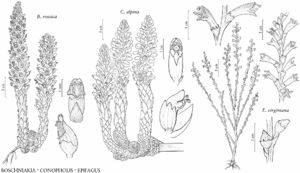Epifagus
Gen. N. Amer. Pl. 2: 60. 1818.
| Taxon | Illustrator ⠉ | |
|---|---|---|
 | Boschniakia rossica Conopholis alpina Epifagus virginiana | John Myers John Myers John Myers |
Herbs, annual; achlorophyllous, holoparasitic, roots coralloid, from among scales of cormlike structure. Stems absent. Leaves absent. Inflorescences terminal, open panicles of racemes; bracts present. Pedicels present; bracteoles present. Flowers: sepals 5, calyx ± bilaterally symmetric, obliquely campanulate, lobes toothlike. Chasmogamous flowers: petals 5 (appearing as 4), corolla white or pale-yellow with purple to reddish purple or reddish-brown stripes, bilabiate, tubular, abaxial lobes 3, adaxial 1 (by connation); stamens 4, didynamous, filaments densely pilose at base, sparsely pilose distally; staminode 0; ovary 1-locular, placentation parietal; stigma capitate or ca. 2-lobed. Cleistogamous flowers: corolla not persistent, purplish red-and-white, rarely pale-yellow, bilaterally symmetric, calyptriform; stamens included, anthers connate, adnate to stigma; corolla, stamens, and style shed as unit. Capsules: dehiscence loculicidal. Seeds 500–600, pale amber, narrowly ovoid to oblong-ellipsoid, not or only slightly flattened, wings absent.
Distribution
c, e North America, ne Mexico
Discussion
Species 1.
Epifagus is the only genus among the holoparasites to produce cleistogamous flowers. The relative occurrence of cleistogamous and chasmogamous flowers varies from plant to plant.
The cormlike structure of Epifagus is entirely underground and differs from the stems of Boschniakia, Conopholis, and Kopsiopsis by having both scales and coralloid roots. The racemes emerge directly from the base; there is no aerial stem. Floral buds occur in the axils of all bracts, often even those on the cormlike base. Other genera of holoparasites have a well-differentiated vegetative stem that supports the inflorescence.